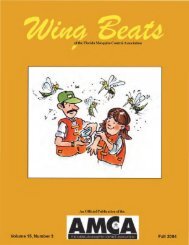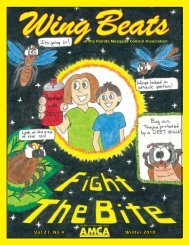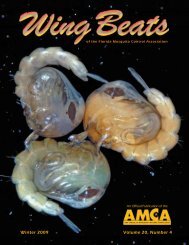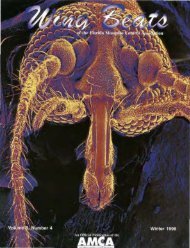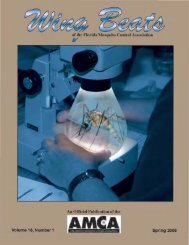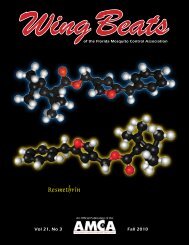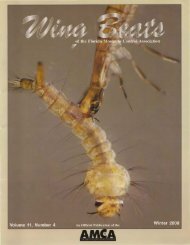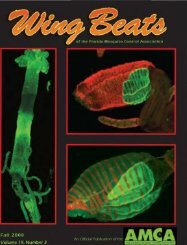Volume 23 Number 1 - Wing Beats - Wing Beats - Florida Mosquito ...
Volume 23 Number 1 - Wing Beats - Wing Beats - Florida Mosquito ...
Volume 23 Number 1 - Wing Beats - Wing Beats - Florida Mosquito ...
You also want an ePaper? Increase the reach of your titles
YUMPU automatically turns print PDFs into web optimized ePapers that Google loves.
8<br />
Figure 6: Uranotaenia lowii feeding on a calling Eastern Narrowmouth Toad, Gastrophryne carolinensis.<br />
generally 60-90% of bloodmeals<br />
taken from amphibians (eg,<br />
Burkett-Cadena et al, 2008). This<br />
places this mosquito towards<br />
the specialist end of the host<br />
generalist-specialist scale,<br />
increasing the expectation of<br />
adaptations fitting the chosen<br />
host. Indeed, Barlett-Healy<br />
et al (2008a) showed in the<br />
laboratory that females of this<br />
species are attracted to frog<br />
calls, particularly the call of<br />
the Spring Peeper, Pseudacris<br />
crucifer, a frog emerging<br />
from hibernation around the<br />
same time that early spring Cx<br />
territans are ready to feed.<br />
Uranotaenia lowii<br />
The genus Uranotaenia is mainly<br />
tropical, with two representatives<br />
in <strong>Florida</strong>: Ur lowii and U r<br />
sapphirina; see Figure 4.<br />
Uranotaenia species are smallbodied<br />
mosquitoes, with many<br />
of the worldwide representatives<br />
thought to specialize on<br />
amphibians (eg, Tamashiro<br />
et al, 2011). Uranotaenia lowii<br />
itself ranges throughout the<br />
southeastern United States and<br />
is likely also an amphibian<br />
specialist, although there are<br />
currently no major bloodmeal<br />
studies to confirm this status.<br />
Spring 2012 <strong>Wing</strong> <strong>Beats</strong><br />
In Vero Beach, Ura notaenia<br />
lowii is locally abundant and<br />
has been observed in numbers<br />
on the Southern Toad, B u fo<br />
terrestris, see front cover;<br />
Squirrel Treefrog, Hyla squirella,<br />
see Figure 5; Green Treefrog,<br />
Hyla cinerea; and even the<br />
tiny Eastern Narrowmouth Toad,<br />
Gastrophryne carolinensis, see<br />
Figure 6. In Costa Rica, Borkent<br />
and Belton (2006) recorded the<br />
attraction of large numbers of<br />
this species to traps using frog<br />
calls as bait, suggesting that Ur<br />
lowii likely uses sound to locate<br />
its host. However, the observation<br />
of feedings on such a variety of



